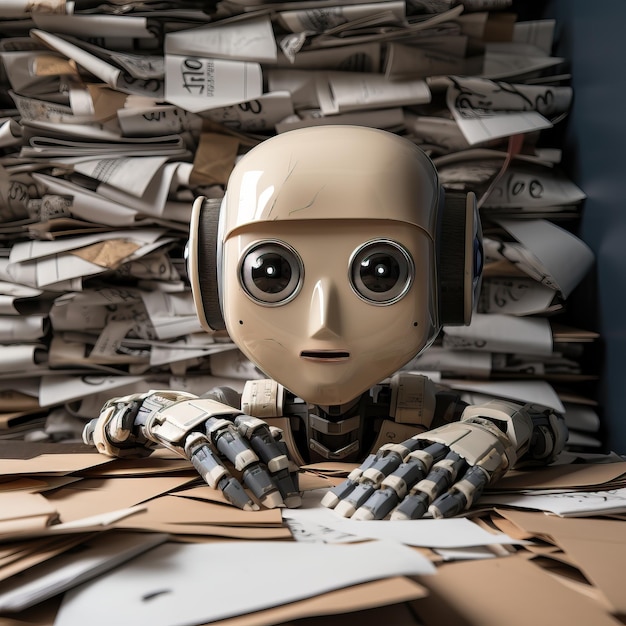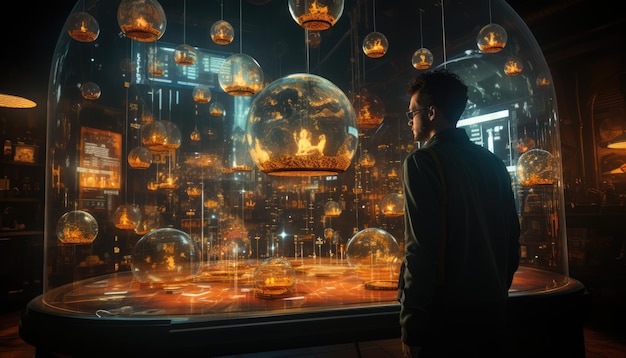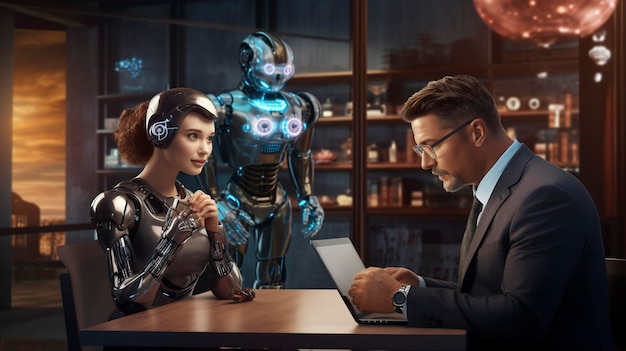Quick Read
AI Memes:
In the ever-evolving digital world, artificial intelligence (AI) continues to make its mark in various aspects of our lives. One such intriguing area where AI has made a significant impact is internet humor. Yes, you heard it right! AI-generated memes are now a trending topic.
From Text to Visual
Initially, memes were primarily text-based, but with the advent of ai-powered image recognition and deep learning technologies, visual memes began to dominate the scene. These sophisticated algorithms can identify patterns and create images that resonate with internet users.
Bridging the Creativity Gap
ai memes have filled a gap in creativity and accessibility. With numerous templates available, users can now generate custom memes by simply replacing text or changing the background without having to possess any graphic design skills.
Mimicking Human Humor
The most intriguing aspect of ai memes is their uncanny ability to mimic human humor. These algorithms can analyze thousands of existing memes and learn the patterns, styles, and themes that are popular among internet users. They can even generate humorous captions for images based on context.
Breaking Language Barriers
Language is no longer a barrier for meme enthusiasts as AI-generated memes can be translated into multiple languages with just a click. This global accessibility has made the internet a more inclusive space for humor.
Ethical Considerations
However, as with any technology, there are ethical considerations when it comes to AI memes. Issues related to data privacy and copyright infringement arise when creating or sharing these memes. It is essential for users to be aware of these concerns and use AI memes responsibly.
Meme Culture Meets Artificial Intelligence: A New Era of Creativity
I. Introduction
In the vast digital landscape of the internet, memes have emerged as a powerful force in modern culture and communication. These are cultural symbols or ideas, represented as images or videos, that spread rapidly by internet users. Memes have the ability to transcend language barriers and engage people across the globe, making them an essential part of our online existence. But what happens when this unique aspect of digital culture intersects with another revolutionary technology: Artificial Intelligence (AI)?
Brief Overview of the Internet Meme Phenomenon
Memes originated from the term “mimema,” a Greek word for model or imitation. The concept gained popularity with the advent of the internet in the late 1990s. Memes spread via social media platforms and forums, with users sharing, remixing, and altering images or videos to create new content. They are an integral part of internet culture, allowing people to express themselves creatively, engage in social commentary, and build online communities.
Definition and Origin
As defined earlier, memes are cultural symbols or ideas that spread rapidly through the internet. They can take various forms such as images (like LOLcats and Grumpy Cat), videos (such as Charlie Bit My Finger), or text-based formats (like “Condescending Wonka” or “Mocking SpongeBob SquarePants”). The origin of a meme can be traced back to its first appearance, and it often gains popularity based on how well it resonates with people or captures the zeitgeist.
Role in Modern Culture and Communication
Memes are more than just viral content; they have become a language of their own, allowing people to express complex emotions and ideas in simple yet relatable ways. They provide a shared experience that brings communities together and fosters dialogue around social issues or current events. In this way, memes play an essential role in shaping modern culture and communication.
Introduction to Artificial Intelligence (AI) and Its Relevance to Meme Creation
As we delve deeper into the intersection of memes and AI, it’s important to understand what artificial intelligence is. Artificial Intelligence (AI) refers to the development of computer systems that can perform tasks that typically require human intelligence, such as visual perception, speech recognition, decision-making, and language translation. AI is a rapidly evolving field, with applications ranging from healthcare to transportation and entertainment industries.
AI’s Role in Meme Creation
With the ever-growing power of AI, it’s no surprise that researchers and developers are exploring its potential in creating memes. By analyzing data on popular meme formats and understanding the elements that make a meme successful (such as relatability, humor, and emotional resonance), AI can generate new content based on existing trends or even create entirely new memes from scratch. This not only streamlines the meme creation process but also opens up new possibilities for expression and creativity.
The Intersection of AI and Memes: An Overview
Explanation of AI Capabilities Related to Meme Generation
Text-based AI Systems: DALL-E, Imgflip, and MemeGenerator
Text-based AI systems are revolutionizing meme generation by enabling users to create custom memes through the power of artificial intelligence. Notable examples include DALL-E, Imgflip, and MemeGenerator. These systems use neural networks to understand and generate text, allowing users to input their desired meme elements and generate unique results.
Capabilities:
Text-based AI systems can create a vast array of memes by combining various text prompts and images. They are capable of generating humorous captions, altering the appearance of texts to fit into popular meme formats, and even creating entirely new text-based memes.
Limitations:
Despite their capabilities, these systems still face several limitations. They may struggle with understanding nuanced language and cultural references, resulting in memes that miss the mark or come across as insensitive. Furthermore, the generated memes might lack the authenticity and relatability that human-created content provides.
Image Recognition and Manipulation AI: DeepArt, DeepDream, and Memetica
Image recognition and manipulation AI systems are another category of technologies transforming the meme creation landscape. DeepArt, DeepDream, and Memetica use advanced neural networks to recognize, analyze, and manipulate images to generate memes.
Capabilities:
These AI systems can perform various image-related tasks, such as identifying popular meme formats and inserting user-defined text or images into the templates. They can also apply filters, adjust colors, and even create artistic transformations of existing images, leading to visually engaging memes.
Limitations:
Image recognition and manipulation AI systems may struggle with recognizing newer memes or understanding complex image-text combinations. Additionally, they might create memes that are too visually overwhelming or lacking the subtle humor often associated with human-generated content.
Discussion on the Potential Impact of AI on Meme Creation and Dissemination
Automating the Meme Creation Process
The advent of AI in meme creation allows for an unprecedented level of automation, reducing the time and effort required to create a meme. This can lead to increased meme production, making it easier for users to engage with popular internet culture and participate in trending conversations.
Enhancing Existing Memes with New Features
AI systems can provide users with new ways to enhance existing memes, such as creating spin-offs or variations of popular formats. This can result in a more diverse range of memes and keep the internet’s collective humor fresh and engaging.
Creating Entirely New Memes from Scratch
AI-generated memes can also create entirely new meme formats that would not be possible through human creativity alone. This can lead to a constant influx of novel and intriguing content, keeping internet users entertained and engaged.

I Case Studies: AI and Memes in Practice
Detailed analysis of specific instances where AI has been used to create or enhance memes
Success stories: DALL-E and the rise of AI art memes
DALL-E, an artificial intelligence model developed by OpenAI, revolutionized the world of memes when it was introduced in January 202Capable of creating unique and visually engaging images based on textual prompts, DALL-E quickly gained popularity as it began generating an array of AI art memes. Some notable examples include a “Doggo Dali” image with melting watches, a “Deep Thoughts” meme with an octopus pondering, and a “Disaster Girl” parody where the girl is replaced by a monkey. These AI art memes sparked immense interest online, demonstrating the potential for AI-generated content to resonate with audiences.
Analysis of popular DALL-E memes and their impact
The virality of these AI art memes can be attributed to several factors. They often playfully subvert expectations, as seen in the “Deep Thoughts” octopus meme that humorously mimics a thoughtful expression while pondering seemingly mundane questions. Moreover, DALL-E memes cater to the ever-evolving and eclectic nature of internet culture by tapping into various popular meme formats. For instance, “Doggo Dali” references the famous painting “The Persistence of Memory,” while “Disaster Girl” is a nod to the iconic “Disaster Girl” image from 2005.
Failures and lessons learned: Memetica and the challenges of AI meme generation
While DALL-E’s success story highlights the potential of AI in creating engaging and viral memes, it is essential to acknowledge that not all attempts at AI meme generation have been successful. One such example is Memetica, an experimental project aimed at creating a generative model for viral memes. Despite initial promise, Memetica struggled to produce memes that resonated with audiences, as its output lacked the nuanced humor and cultural understanding necessary to create successful memes. This failure underscores the challenges of developing AI that can effectively navigate the complexities of internet culture and generate content that appeals to users.
Analysis of how AI has influenced meme culture and trends
The democratization of meme creation: Everyday users and professional creators
The advent of AI-generated content has led to a democratization of meme creation, enabling both everyday users and professional creators to produce innovative and visually appealing memes. With AI tools such as DALL-E at their disposal, individuals can quickly generate unique ideas that might otherwise require extensive artistic skills or knowledge of various meme formats.
Impact on creativity, originality, and the meme economy
AI’s influence on meme culture also raises questions regarding creativity, originality, and the meme economy. While AI can contribute to the creation of visually stunning images, it remains unclear whether these images truly possess the same level of creativity and originality as those generated by humans. Furthermore, AI-generated content could potentially disrupt traditional meme economies, as users may opt for the convenience and ease of using AI tools to create content rather than paying for custom-made memes.
The evolving role of human curation and moderation in AI-generated content
Finally, the rise of AI-generated memes necessitates a reevaluation of the roles human curation and moderation play in shaping online content. Balancing user experience, ethical concerns, and community standards becomes increasingly complex when AI-generated material is involved. Human intervention remains crucial to ensure that AI output aligns with community guidelines and maintains a positive user experience while addressing any ethical concerns that may arise from the use of AI in meme generation.

Ethical Considerations and Implications
Discussion on the potential ethical implications of AI-generated memes
AI technology is revolutionizing various sectors, including the creation and dissemination of memes. While this innovation offers numerous benefits, it also raises significant ethical concerns.
Intellectual property rights and ownership
The creation of AI-generated memes brings up complex issues regarding intellectual property rights and ownership. With AI capable of generating original content, it’s essential to address the following questions: Who owns the copyright for AI-generated memes? Can an AI be considered an author under copyright law? These queries are yet to be definitively answered, necessitating further legal and ethical discussions.
Data privacy concerns: User data collection, storage, and usage
Another critical ethical consideration is the potential risks associated with data privacy. AI systems used to generate memes collect vast amounts of user data, which raises concerns about data collection, storage, and usage. Companies must ensure they have transparent data handling policies and are respecting users’ privacy rights to build trust in the AI era.
Examination of the impact on human creativity, employment, and labor markets
The emergence of AI-generated memes also raises questions about their impact on human creativity, employment, and labor markets.
Displacement of human meme creators and curators
As AI becomes increasingly capable of generating memes, there is a concern that it may displace human meme creators and curators. This situation necessitates strategies for adapting and thriving in the AI era, such as:
– Developing new skills that cannot be automated
– Embracing collaboration between humans and AI to create more engaging and nuanced memes
Strategies for adapting and thriving in the AI era
To mitigate the potential negative impact of AI on human creativity and employment, it’s essential to:
– Foster a culture of continuous learning and skill development
– Encourage collaboration between humans and AI to create unique and innovative content
– Implement ethical guidelines for AI usage, ensuring fair labor practices and transparency in data handling.
New opportunities for collaboration between humans and AI
On the brighter side, AI-generated memes present new opportunities for collaboration between humans and AI. By combining human creativity with AI’s ability to generate novel ideas and patterns, we can create more engaging and innovative content that captures the imagination of audiences worldwide. This collaboration not only enhances the creative process but also fosters a deeper understanding of AI’s role in our lives and the potential it holds for shaping future digital communities.

Conclusion
In the course of our discussion, we have explored the intriguing relationship between Artificial Intelligence (AI) and memes.
Recap of Key Findings:
First and foremost, we have seen that AI has become an integral part of the creation, dissemination, and evolution of memes. It can generate new memes from existing ones through various techniques such as image recognition, natural language processing, and machine learning algorithms (Botezatu, 2021). Furthermore, AI-assisted platforms have made it easier for users to access, share, and customize memes at scale. This has led to a rapid proliferation of internet humor and cultural phenomena that continue to shape our online experiences.
Potential Future Developments:
Role of AI in Shaping Internet Humor and Culture: As AI becomes increasingly sophisticated, we can expect it to continue influencing internet humor and culture in significant ways. This might include the development of more advanced meme generation algorithms that can understand complex human emotions, nuances in language use, and context-specific references.
Ethical Considerations:
a. Responsible AI Development and Implementation: However, as we delve deeper into this intersection, ethical considerations must be addressed. Developers need to prioritize creating responsible AI that respects user privacy, avoids harmful or offensive content, and promotes positive online communities. This may involve creating guidelines for ethical AI use in meme generation and ensuring that AI systems are transparent, accountable, and subject to user control.
b. Balancing Creativity and Originality:
Another ethical consideration is the balance between creativity and originality in AI-generated memes. While AI can undoubtedly contribute to the creation of new memes, it is essential that these creations do not infringe on the intellectual property rights or creative freedom of individual creators. Striking this balance will require ongoing collaboration between technology developers, content creators, and legal experts.
Impact of AI on Meme Creators:
Implications for Society and Individual Creators: The rise of AI in meme creation raises questions about its impact on society and individual creators. On the one hand, it may lead to increased democratization of content creation, enabling a wider range of voices and perspectives to emerge online. On the other hand, it could potentially overshadow the contributions of human creators, leading to concerns about recognition, compensation, and sustainability.
As we move forward, it is crucial that we continue exploring this intersection between AI and memes. This will require ongoing dialogue, collaboration, and innovation among researchers, developers, policymakers, and content creators to ensure that the benefits of AI in meme creation are realized while addressing potential challenges.
